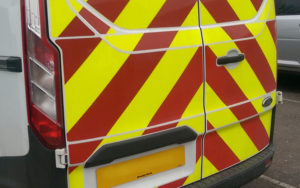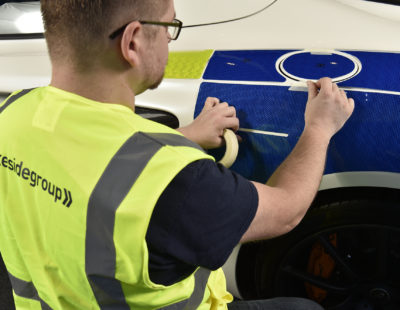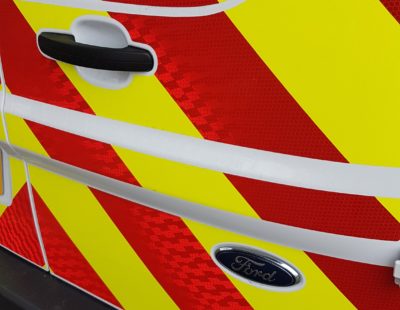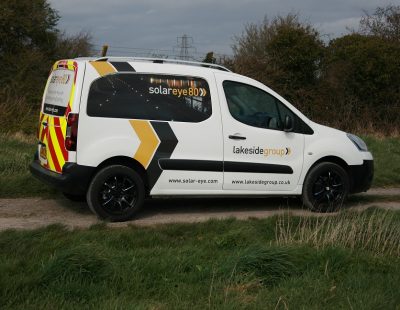There is a wide range of reflective materials available as well as important regulations that may be relevant depending on the vehicle type. Therefore, for someone sourcing reflective materials for vehicles, choosing the right one can be challenging.
Whether you are looking for reflective materials to make your vehicle more visible on the road during the night or simply to enhance your branding, our experts at Lakeside can help! We’ve put together this buyer’s guide to explain everything you need to know about reflective materials for vehicles, including types of material and the regulations that surround them.
UK regulations for reflective materials for vehicles
It’s important buyers familiarise themselves with relevant regulations before purchasing reflective materials that may not be legally allowed for the application.
Currently, the law surrounding decorating and adorning a vehicle with reflective elements is not entirely clear. So long as elements are small and mainly on the side of the vehicle, like a logo, there should be no issues. Businesses looking to apply vehicle reflectives for brand enhancements should consider regulations mentioned in this guide and consult a reflective supplier to ensure compliance.
Retro-reflective conspicuity vehicle markings, i.e. those for visibility purposes not brand enhancement, have rules as laid out by The Road Vehicles Lighting Regulations 1989. Within these regulations there is clarification over the colours of retro-reflective materials that should be used on vehicles according to the position. For example, rear markings must be red, side must be amber, and front any colour except red (white is recommended).
Find out more in the ‘schedules’ section of the regulations.
Certain vehicles have specific regulations, namely Chapter 8 regulations for vehicles that stop on public highways for works, ECE104 contour tape requirements for HGVs, and emergency vehicle conspicuity markings. The correct reflective materials for these particular vehicles will be explored below.
Types of reflective materials for vehicles
Reflective materials, as the name suggests, reflect light back to its source; anything that reflects more than light, like an image, is likely chrome or mirror. Fluorescent materials, opposed to reflective materials, glow under sunlight but do not reflect light at night.
Reflective vinyl is usually either glass bead or prismatic, the difference being in the construction and performance of the two. Glass bead material is made of exactly that, glass beads which are then embedded on a metallised sheet, which reflects light. Prismatic vinyl is a much brighter reflective, formed of thousands of micro-prisms embossed into a durable film to reflect far more efficiently.
See more: A Buyer’s Guide to Reflective Vinyl
Buyers must know the type of reflective material they are purchasing as some applications require certain performance capabilities. For example, only prismatic materials can be used for specialist applications such as emergency vehicles, for which visibility at night cannot be inadequate.
There are also various grades of reflective materials to choose from. Suitable and recommended grades for certain applications are listed below.
Reflective materials for vehicles: brand enhancement
Digitally printable reflective materials are popular with businesses looking to adorn a vehicle (or entire vehicle fleet!) with branded assets. From race cars to regular road cars, brand enhancement on vehicles is regularly employed for promotional purposes.
See more: Branding tips for small businesses
Printable materials allow businesses to choose exactly what they want on their vehicle, with total freedom in shape and colour. Although the above stated regulations restrict the use of various colours of reflective materials on vehicles on public highways, for the most part, logos and smaller assets are acceptable.
For expert advice on brand enhancement and supply of quality printable reflectives, get in touch with Lakeside! We supply and create flexible, adhesive vehicle reflectives for brand enhancement. Buyers should check out our popular Aura Optical Systems 124 and Avery Dennison V4000 VisiFlex brand enhancement solutions.
Reflective materials for vehicles: emergency vehicles
Emergency vehicles in England have their own set of regulations and standards to ensure that all fire engines, ambulances, police cars and other emergency response vehicles are recognised and visible during day and night. Highly retro-reflective materials keep workers and vehicles safe on the road; it is therefore paramount that quality, reputable materials are sourced for these purposes.
CAST 14/04 is the relevant grade specification for emergency vehicles and BS-EN-1789 is the UK/EU specification for ambulances.
Our Avery Dennison V8000 VisiFlex vinyl is the number 1 choice for emergency vehicles, offered in 6 colours to suit all emergency vehicle applications. Lasting for over 7 years and engineered with solid construction for durability, VisiFlex is designed to keep emergency vehicles bright for years to come.
Check out our case studies to see V8000 VisiFlex in action.
Reflective materials for vehicles: Chapter 8
Vehicles that stop or are used for work purposes on highways or high-speed roads must have rear retro-reflective chevrons to alert road users to their presence, as outlined by Chapter 8 of the Department of Transport’s Traffic Signs Manual. To find out more, read our blog on Chapter 8 compliant vehicle reflectives.
Lakeside stock a full range of Chapter 8 and Safety at Street & Road Works compliant reflective materials for vehicles, from high grade R2 to R3B micro prismatic products. As members of REMA (Reflective Equipment Manufacturer Association), we helped to create guidance on Chapter 8 compliance, we can advise on the best products for you.
Reflective materials for vehicles: ECE104
Heavy Goods Vehicles over 7.5 tonnes manufactured after 2011 and trailers over 3.5 tonnes must have conspicuity tape on the front, side and back to outline the vehicle and help reduce traffic collisions, especially during dark hours (specified by ECE104). Conspicuity tape must be reflective and of high standard to effectively reflect and remain durable for years to come.
Class C grade is specified for white, yellow and red markings for ECE104 vehicles. For HGV vehicles, graphics of any colour, class D and E are specified.
For long-lasting conspicuity tape in red, white, and yellow, see Avery Dennison’s range of tape with solid construction for bolstered durability.
Get reflective materials for vehicles with Lakeside
Here at Lakeside we have other 30 years’ experience in the traffic safety industry, sourcing and supplying the best quality reflective materials for a range of applications. Our extensive product range covers all vehicle reflectives, traffic signs, and other street furnishings.
As members of REMA, we can help buyers find the best options to suit their needs.
Get in touch with our friendly team today!




